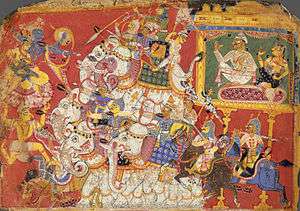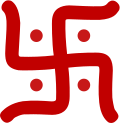Narakasura
| Narakasura | |
|---|---|
 Krishna and Satyabhama fighting Naraka's armies - Painting from the Metropolitan Museum | |
| Information | |
| Gender | Male |
| Family | Bhauma |
| Spouse(s) | Maya (Princess of Vidarbha) |
| Children | Bhagadatta (Son) |
| Relatives | Bhudevi (mother), Varaha (father) |
| Religion | Hinduism |
| Part of a series on |
| Hindu mythology |
|---|
 |
| Sources |
| Cosmology |
| Deities |
| Personalities of the Epics |
| Hinduism Portal |
| Part of a series on the | ||||||||
| Mythology of Pragjyotisha | ||||||||
|---|---|---|---|---|---|---|---|---|
 | ||||||||
| Ruling dynasties | ||||||||
|
||||||||
Narakasura was a legendary figure, the progenitor of the Bhauma dynasty of Pragjyotisha. He is considered to be a son of Bhudevi, fathered by Vishnu in his Varaha incarnation[1]. He is claimed as one who established Pragjyotisha. He was killed by Krishna and his son. Bhagadatta of Mahabharata fame, succeeded him.
In the Kalika Purana he is claimed to have come from Mithila and said to have established the kingdom of Pragjyotisha after overthrowing the last of the Kirata king Ghatakasura of Danava dynasty. It was foretold that he would be destroyed by a later incarnation of Vishnu. His mother, the earth, sought the boon from Vishnu that her son should have a long life, and that he should be all powerful. Vishnu granted these boons.[2]
The legend of Naraka is important in the history of Assam, particularly Kamarupa; since Narakasura is cited as the progenitor of all three dynasties that ruled Kamarupa in historical times. A hill, to the south of Guwahati is named after him.[3] He is also associated with the Hindu belief of the shakti goddess and place of worship Kamakhya.[4]
History of the legend
Narakasuran and his kingdom, Pragjyotisha, find mention in both the Mahabharata and the Ramayana, in the sections which were written not before the first century,[5] where he is not depicted as the son of Bhudevi (earth) and Varaha incarnation of Vishnu.[6] His son, Bhagadatta, is said to have fought for the Kauravas in the Mahabharata battle. Though the boar Prajapati finds mention as early as the Satapatha Brahmana and the Taittriya Aranyaka from the mid first millennium BCE, the avatars were associated with Vishnu later,[7] and became popular in the Gupta period[8] (320-550 CE) and that the contact with Bhumi engendered a son is first mentioned in the Book II of the Harivamsa[9] which is assigned to the fifth century. This theme, that of the son Naraka, is further expanded in the later Vishnu Purana (5th-9th century). In the 7th-century copper place inscriptions, Naraka is claimed as the originator of the Varman dynasty and that he lived three thousand years earlier.[10] The Bhagavata Purana (8th-10th century), which was composed even later, expands the story even further. The Naraka myth gets the most extensive elaboration in the Upapurana called Kalika Purana (10th century), which was composed in Assam itself. Here the myth of Janaka of Videha, the father of Sita, is embellished and added to the myth of Naraka.[11]
According to other accounts, Naraka is not the son of Vishnu but of Hiranyaksha, an Asura.[12]
Legend


The pious Naraka became evil, in association with Asura named Banasura and 'asura' (demon) was added to his name.[13]
Once Naraka, motivated by his carnal desire, wanted to marry Devi Kamakhya. When proposed, the Goddess playfully put a condition before him that if he would be able to build a staircase from the bottom of the Nilachal Hill to the temple within one night before the cock crows to indicate Dawn, then she would surely marry him. Naraka took it as a challenge and tried all with his might to do this huge task. He was almost about to accomplish the job before it was dawn. When Kamakhya Devi got this news, panic-stricken she strangled a cock and made it crow untimely to give the impression of Dawn to Naraka. Duped by the trick even Naraka thought that it was a futile job and left it half way through. Later he chased the cock and killed it. Now the place is known as Kukurakata situated in the district of Darrang. The incomplete staircase is known as Mekhelauja Path.[14]
Drunk with power, as he knew himself to be unrivalled in prowess, he brought all the kingdoms on earth under his control. Next, he turned his eyes towards Swargaloka. Even the mighty Indra could not withstand the assault of this son of Vishnu and had to flee the heavens. Narakasura had become the overlord of both the heavens and earth. Addicted to power, he stole the earrings of Aditi, the heavenly mother goddess, and usurped some of her territory, while also kidnapping 16000 women.[15]
All the Devas, led by Indra, went to Vishnu to ask him to deliver them from Narakasura. Vishnu promised them that he would attend to this matter, when he would be incarnated as Krishna.[16]
As promised to Mother Earth, Narakasura was allowed to enjoy a long reign. At last Vishnu was born as Krishna. Aditi, who was a relative of Krishna's wife Satyabhama (believed to be an Avatar of Bhudevi - Narakasura' mother), approached Satyabhama for help. When Satyabhama heard of the Narakasura's ill treatment of women and his behaviour with Aditi, she was enraged. Satyabhama approached Lord Krishna for permission to wage a war against Narakasura. As promised to the Devas and Aditi, Krishna attacked the great fortress of Narakasura, riding his mount Garuda with wife Satyabhama.
Lord Krishna used the Narayanastra and the Agneyastra against the army of Narakasura.
The battle was furiously fought. Narakasura possessed 11 Akshauhinis that he unleashed on Lord Krishna. However, the Lord slew them all with little effort. Lord Krishna also killed Mura, Narakasura's general. Thus Krishna is called 'Murāri' (the killer of Mura).[17]
Narakasura used several divine weapons against Lord Krishna, but Lord Krishna easily neutralised all those weapons.
Narakasura used the Brahmastra against Lord Krishna, but Lord Krishna neutralised it with his own Brahmastra. Narakasura used the Agneyastra against Lord Krishna, but Lord Krishna neutralised it with the Varunastra. Narakasura used the Nagastra against Lord Krishna, but Lord Krishna neutralised it with the Garudastra.
In desperation, Narakasura launched the Vaishnavastra on Lord Krishna, but Lord Krishna neutralised it with another Vaishnavastra.
At last, when Narakasura tried to kill Lord Krishna with a trident, Lord Krishna beheaded him with his Sudarshana Chakra (discus).[18]
Before Narakasura's death, he requested a boon from his mother, Satyabhama, that everyone should celebrate his death with colorful light. Thus this day is celebrated as 'Naraka Chaturdashi' - the day before Diwali. Krishna's and Satyabhama's victory on Narakasura translated into freedom for all his prisoners and honoring of Aditi.[19]
See also
| Wikimedia Commons has media related to Narakasura. |
References
Citations
- ↑ Srimad Bhagavatam. The Bhaktivedanta Book Trust International, Inc. p. 3.3.6. Archived from the original on 3 November 2013.
- ↑ George M. Williams (2008), Handbook of Hindu Mythology, p.222
- ↑ Siba Pada Sen (1980), Sources of the history of India - Volume 3, p.69
- ↑ Biswanarayan Shastri, Indira Gandhi National Centre for the Arts (1994), Kalikapurana, p.xxviii
- ↑ (Sircar 1990:81)
- ↑ (Sircar 1990:83)
- ↑ (Sircar 1971:41–42)
- ↑ (Sircar 1990:85)
- ↑ (Sircar 1990:85)
- ↑ "The mythical ancestors of this line of rulers were Naraka, Bhagadatta and Vajradatta. Three thousand years after these mythical ancestors there occurred Pushyavarman..." (Sharma 1978, p. xxix) In the Nidhanpur copperplate inscription, it is mentioned: "When the kings of his (Vajradatta's) family having enjoyed the position (of rulers) for three thousand years had (all) attained the state of gods, Pushyavarman became the lord of the world." (Sharma 1978, p. 50)
- ↑ (Sircar 1990:87–90)
- ↑ (Smith 2007:167)
- ↑ Chandra Dhar Tripathi (2008), Kāmarūpa-Kaliṅga-Mithilā: a politico-cultural alignment in Eastern India : history, art, traditions, p.98, p.p 197
- ↑ Kāmarūpa Anusandhān Samiti (2007),Journal of the Assam Research Society - Volume 38,p.30
- ↑ Swami, Parmeshwaranand (2001). Encyclopaedic Dictionary of the Puranas. New Delhi: Sarup and Sons. p. 941. ISBN 8176252263.
- ↑ B. K. Chaturvedi (2017), Vishnu Puran
- ↑ Dianne M. MacMillan (2008), Diwali: Hindu Festival of Lights, p.24
- ↑ Ayilam Subrahmaṇya Pañcāpageśa Ayyar (1957), Sri Krishna: The Darling of Humanity, p.42
- ↑ Muriel Marion Underhill (1991), The Hindu Religious Year, p.59
References
- Smith, William L (2007). "Assam: Shankaradeva's Parijata Harana Nata". In Bryant, Edwin. Krishna: A Source Book. Oxford University Press. pp. 163–186.
- Sharma, Mukunda Madhava (1978). Inscriptions of Ancient Assam. Gauhati University, Assam.
- Sircar, D C (1990), "Epico-Puranic Myths and Allied Legends", in Barpujari, H K, The Comprehensive History of Assam, I, Guwahati: Publication Board, Assam, pp. 79–93
- Sircar, D C (1971), Studies in the Religious Life of Ancient and Medieval India, Delhi: Motilal Banarasi Das
- Vettam Mani (1976), Puranic Encyclopedia: Comprehensive Dictionary with Special Reference to the Epics and the Puranas, South Asia Books.